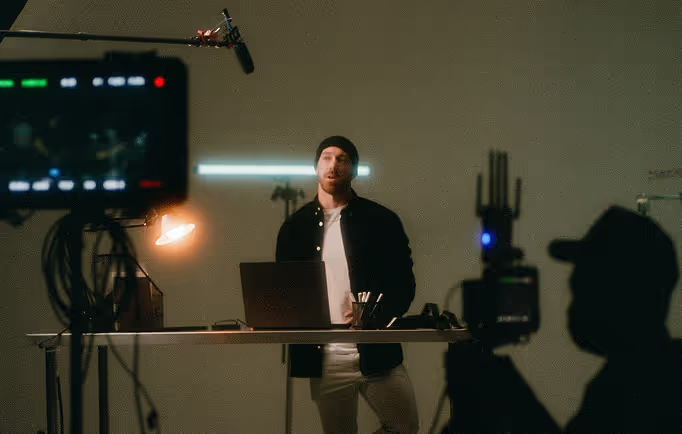Why Is Whiteboard Animation So Damn Popular?

Every couple of years there seems to be a new fad in corporate video. When whiteboard animation first came swaggering onto the scene it too seemed like the kind of phenomenon that would enter with a blaze of glory and fade shortly after with not so much as a whimper. Yet here we are several years later and whiteboard animation is still going strong, like a reality TV show nobody quite understands the appeal of but everybody keeps on watching.
Surprisingly, the answer to this appeal lies largely in the psychology behind what we’re watching. There are several subconscious reasons we’re drawn toward whiteboard animation, and today we’re shedding a little light on how they fit together.
1) a satisfying puzzle
There’s something oddly satisfying about watching an in-progress drawing be completed before your eyes. It’s like putting in the last piece of a puzzle, or taking the last bite of a delicious sandwich and not leaving a single trace of morsels behind (why yes, I am writing this paragraph directly before lunch. How did you guess?). The sense of completion is irresistible. This phenomenon works strongly in favour of a message requiring audience retention, because once the artist starts each drawing it becomes more difficult for a viewer to tune out and miss out on the finished product. As usual, put your most important/engaging information first to catch the eyes and ears of casual viewers, then funnel down to your smaller steps while allowing the whiteboard drawing process to carry remaining viewer attention through to the call of action.
2) a human touch (literally)
Obvious as it might seem, we humans are naturally drawn to each other. The reason we so easily recognise 🙂 as a smile and ;( as some kind of weird sad wink is because we’re neurotypically wired to look for faces. A human face tells us whether another person is angry with us (signalling danger), happy and having fun (signalling acceptance), or sad (signalling a need for community). In lieu of a face, hands have a similar magnetic power. The presence of a live human hand draws our attention, and the visual communication of the whiteboard drawing keeps it going. In this way, whiteboard animation helps tap into a core part of our human psyche – we want to connect, and we want to understand.
3) gearing up your mind for education
There’s something to be said for the automatic association we make with blackboards/whiteboards and learning. Whether it’s the classroom or the boardroom, a drawing board puts us in the frame of mind that we’re going to be absorbing information. When the whiteboard narration starts, our minds are ready to take in, and more importantly retain, the information fed to us. The fun, artistic style of whiteboard videos also means we don’t get the same ‘learning fatigue’ that we do from staring at a page of graphs and technical diagrams.
4) mimicking step-by-step information
Effective teaching is all about knowing your students’ learning curves. Throwing too much information all at once is overwhelming, while too little is boring. Information needs to be released gradually for it to be absorbed, starting with the skeleton and building upon that to create a complete picture. Conveniently, a whiteboard drawing is the perfect visual accompaniment for this style of learning as the image forms in front of your eyes just like the information. Whiteboard videos are generally sped up from real-time too, meaning information is relayed efficiently for a video-consuming audience.
5) forced simplicity
There’s a two-part reason you don’t see whiteboard videos with hyper-realistic, fully rendered drawings: 1) Hey, we can only draw so fast, and 2) The brain is wired to pay attention to simplicity. If you want someone to remember a new concept your two best bets are to break complex ideas into smaller steps, and then to present one step at a time. The forced simplicity of a live drawing keeps the audience (and the writer of the video script) focussed on one idea at a time.
6) accessibility
Accessibility is a major upside to the lack of real life human presence in a cartoon. Anyone can like a cartoon, and we get less hung up on looking for a representation of ourselves than we do with a video of real people. The appeal of a cartoon comes from the artist’s technique rather than an actor’s presence or looks, meaning a message can be spread more widely to a broader audience.
7) line appeal
A line art drawing contains a totally different appeal to a fully-rendered colour picture. Line art like the style commonly used in a whiteboard drawing focuses on the artistic concept of form rather than texture or colour. With line art we look to outlines to give us an idea of a character’s position and movement, the line of action, which allows the artist to say more with less.
That’s not to say line art is necessarily child’s play: the use of cross-hatching, line weight and tone can all lead to complex works of realism. But generally with whiteboard animation the simplicity is there both for the audience to easily follow along, and to keep labour costs down for the company commissioning the project.
conclusion
It’s easy to see why whiteboard animation has developed its own genre within the corporate video scene. It’s quite unlike anything else out there, and has a visual flavour all its own. Understanding the deeper reasons behind its visual and story appeal helps us develop more engaging content, sharper writing and evolving visual practices for wider future audiences without suffering the stale fate of video fads of the past.
Start a






